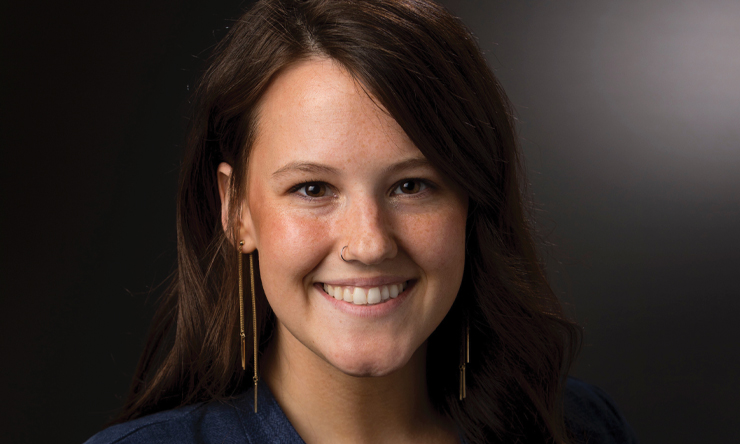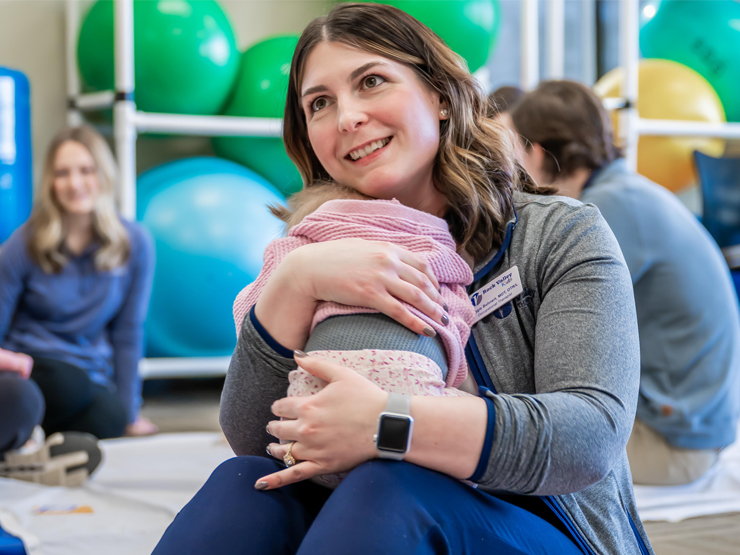Scene Magazine | Summer 2006
Charlie peers out of his grass-lined glass aquarium into the third grade classroom. Rescued last fall from the jaws of a Labrador retriever, the box turtle has lived among St. Ambrose 2004 alumna Rachel Sampson's students all year. However, he hasn't had the chance to provide Sampson's class with many opportunities for extra learning. Third grade science units at Adams Elementary in Davenport are limited to nutrition, the moon and water. So taking time to learn about turtles might be classified as misspent. And a field trip to the woods to return Charlie to his home would require bus money the district doesn't have.
Welcome to American public education in the 21st century. While a confluence of challenges continually put the best teachers, schools and programs in the country to the test-from funding cuts to growing class sizes, and teacher shortages to socio-economic issues that virtually guarantee failure for some children-a five-year-old federally-mandated program requiring schools to prove their students' success via standardized tests has become a flashpoint for what's wrong with our educational system today.
Created in 2001, No Child Left Behind has been used to measure and compare students' math and English scores. Beginning next year, that measurement will expand to include science. And the bottom line is that NCLB is intensifying every challenge that preceded it-and complicating the job of higher education as it strives to prepare teacher candidates for today's classrooms. Instead of following their instincts, teachers now often must follow a curriculum that adheres to test content, with daily practice to ensure all students perform at grade level.
High Stakes All Around
That's a tough order to fill, says St. Ambrose Education Professor Marcia Less, especially when you consider the various levels of ability, interest and desire found in most public school classrooms. For instance, several students in Sampson's class almost qualify for special education assistance, and others are so bright they don't need test practice.
"We teach our education majors to try to meet the needs of every single student," Less explains. "But in today's climate, that's becoming impossible. High-stakes testing means every student in your classroom must be able to perform at their grade level, or it could cost you a raise or even your job."
That squeezes the system both ways, Less says. Although recent Iowa legislation is expected to raise the state's national ranking for teachers' salaries from 41st to 32nd, pay is hardly an incentive for entering education in the first place, which contributes to the growing problem of unfilled job openings. According to George Maurer, executive director of the Board of Educational Examiners with the Iowa Department of Education, the teacher shortage is expanding, particularly in the secondary schools, and most especially in such areas as math, science and special education.
"For example, we have 70 physics teachers due to retire in the next five years, while only five students are in the pipeline," Maurer notes.
Preparing highly-qualified administrators is crucial as well, as the shortage of education professionals also affects administration ranks. Graduate degree programs, such as the new master's of education in educational administration developed in partnership by St. Ambrose and Loras College, are designed to help alleviate such shortages by providing current teachers with the core knowledge, skills and abilities to lead their schools, Less says. Along with St. Ambrose's master of education in teaching and master of education in special education programs, the MEA program provides teachers with ways not only to advance and increase their pay but, more importantly, better serve their students.
Discerning the Need
Maurer suggests another way to address teacher shortages is to encourage students to major in areas other than elementary education. "Although elementary numbers are tracking down this year, we still have too many elementary teachers. Field experience lets teacher candidates ask themselves, 'Do I want to continue with this program? At what level do I want to teach?'"
Such discernment has been a key component of SAU's teacher education program-and key to its success, with 860 graduates in the past ten years. SAU teacher candidates complete four times more field-experience hours than mandated by the state. This helps them to land where they are best suited, as an informal survey of nine seventh-grade teachers at Davenport's Smart Intermediate School revealed. Seven of the teachers had originally planned to teach first- or second-grade but had discovered, during their SAU field experience, their true calling in middle school.
They reiterate one of the biggest challenges of teaching this age group in a high-stakes testing climate. "No standardized test takes into account interpersonal skills," says Smart teacher Jeff Corman '97. "Those skills are key to successful adult behavior. These students come from such diverse backgrounds that standardized tests can't measure what each student has learned."
Real Life, Real Learning
Across town from Sampson's school, David Heinrichs' sixth-grade science classroom at the historically diverse J.B. Young Intermediate School is a case in point: no two students are alike.
Heinrichs '94 says his students respond best "when they can get their hands dirty and be social. This stuff is connected to real life.
"When they leave the classroom, they can understand why a little dribble of rust is coming out of that rock, or why the clouds look the way they do," he explains.
"Real life" is one of the keys to real learning, says SAU education professor Rachel Serianz. "Students need to create knowledge, not just memorize facts," she says. "They are social learners. They need to use games, art and music to acquire hands-on experiences with the material. Spending classroom time filling in bubbles and practicing unrelated questions just to get students ready for a test will not engage them."
Serianz shows her St. Ambrose education students how to provide such real life learning in her science methods classes, which she repeats on a smaller scale each summer for working teachers in the community. Dovetailing with Iowa Department of Education recommendations to provide elementary teachers with a stronger content base and the tools to motivate and engage students, SAU's summer science workshops offer projects, strategies and take-home kits of materials to area teachers. The second week of the workshops is a science camp for kids taught by the workshop graduates.
The science workshops are only a few among the many education initiatives SAU takes into the community, as Serianz' colleague Deanna Stoube points out. "Our Reading Clinic teaches our students how to teach reading using assessment, planning and creativity. They get to practice what they learn out in the community by teaching elementary students who need a little more help. Enhanced reading skills certainly help boost test scores."
The Lessons of Engagement
Hands-on engagement is a pedagogy that works especially well at schools like Davenport's Lincoln Academy for the Arts, which has redoubled its efforts to reach students through their natural interests. For kindergarten special education teacher Jen Koning '99, '04, that means providing her students with lots of ways to engage and to succeed.
Koning says that when her students came to school this past fall, "they were very down on themselves. They have profound behavior disorders. I did everything I could to make learning fun, just as I was taught at St. Ambrose. Their special ed program prepared me to think out of the box."
It's not only primary-age students who respond to such methods of learning.
"Connections to real life are critical to helping students develop a love of learning," says Jenni Weipert '97, Davenport Central High School associate principal, echoing an article in the May/June 2006 issue of Teacher Magazine. It cites statistics that show one third of the students who begin ninth-grade drop out before graduation, while half of those who graduate cannot read well enough to succeed in college or the work place. The article argues that standardized assessments don't address the reasons for student failure, which include turbulent home life and the commonly expressed sentiment from students that school is irrelevant and boring.
"That type of scenario is common today, with our highly-mobile society," Less says. "It's compounded by socio-economic issues that may result in a lack of parental involvement in school. Sometimes parents are too busy working to talk about homework. Their focus is on meeting basic family needs of putting food on the table and providing a home for their children. We educate our teacher candidates to discover strengths in each child and to share that information with families in a positive way. We encourage them to connect learning to real life, so at-risk students will find education meaningful. We sensitize them to identify different learning styles. Teachers today need a lot of tools, strategies and creativity to reach all children so that they learn best."
Says Weipert, "St. Ambrose taught me to use this formula: Number one, what do kids like? And number two, what do they need to know? It prepared me for evaluating whether my methods were working. It prepared me to stay flexible and try something else if they failed. As an administrator, it prepared me to know what to look for in another teacher's classroom. It prepared me to know how to help her or him switch gears when needed."
A call to teach, a call to action
"The bottom line is, we need to back off of high-stakes testing and let teachers do their jobs," Less concludes. "We teach our education students to create learning environments that meet the needs of each of their students, and those needs will vary. We teach our students to respond to the multiple intelligences and learning styles that exist. It's based on solid research, but it's also common sense."
And despite these challenges, teachers agree: Teaching is a calling and labor of love. Charlie the Turtle may have to lumber back into the woods without an audience this summer, but Sampson won't dwell on that. There are other, relevant things to learn. For instance, the children are playing a memory game called Change Three Things, which provokes hoots of laughter as they take turns stumping each other with suddenly untied shoes and missing necklaces.
It is these "tools, strategies and creativity," gained at St. Ambrose, that Sampson most treasures. They help her fulfill her calling to help children create knowledge to last a lifetime.
News
Share This Story



